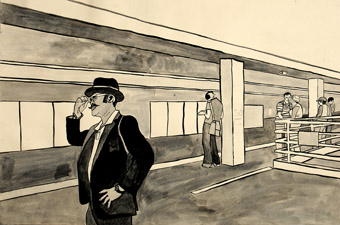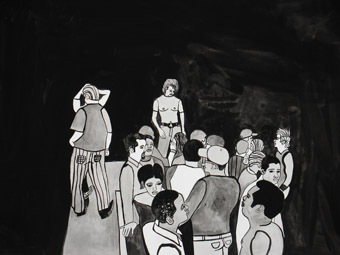stop-start beat: walking the city
saige walton: sadie benning’s play pause, whitney museum, new york

Drawings for Play Pause 2001-06, Gouache on Paper, collection of the artist.
© Sadie Benning
Drawings for Play Pause 2001-06, Gouache on Paper, collection of the artist.
TO TELL THE STORIES OF THE CITY, MICHEL DE CERTEAU REMINDS US, YOU CANNOT APPROACH URBAN SPACE FROM ON HIGH. YOU HAVE TO BEGIN WITH THE FOOTPATH. FOR DE CERTEAU, THE CITY COMES TO LIFE AT THE GROUND LEVEL WHERE, CLASPED BY THE BUSTLE OF THE STREETS, BODIES WILL ENCOUNTER ONE ANOTHER IN VARYING MODES OF CONNECTIVITY (AS LOVERS, FRIENDS, WORK COLLEAGUES, OBLIVIOUS PASSERS-BY). IN THE CITY AS LIVED-SPACE, PEDESTRIANS TREAD THEIR OWN EXPRESSIVE PATHS OF CIRCULATION AND CONNECTION AND PHYSICALLY ‘WRITE’ URBAN SPACE IN WALKING IT. ON THE STREET, ACCORDING TO DE CERTEAU, THE STORIES OF THE CITY ARE SPOKEN BY A CHORUS OF FOOTSTEPS.
On view earlier this year in the lobby gallery of the Whitney Museum of American Art, Sadie Benning’s latest video installation, Play Pause (2006), captures the chorus of footsteps that make up a day-in-the-life of an anonymous, post 9/11 city. The installation begins, fittingly enough, with hand-drawn scenes of the street, accompanied by an audio-track of echoing footsteps, traffic noises and chirping birds. Play Pause then proceeds to move through hundreds of Benning’s gouache on paper illustrations (created by the artist between 2001 and 2006) which are projected onto two adjoining screens. Arranged in a loose narrative structure and scanned for two-channel projection, the gouaches of Play Pause detail the movements, gestures and everyday practices of a multitude of nameless urban inhabitants. Benning’s characters walk the city, they idle about on the footpath and loiter in doorways; they wait for the bus, travel the subway, watch television, drink, flirt and dance in bars.
Largely black and white, with occasional chromatic flashes of red, green and blue filters, the gouaches of Play Pause favour schematic outlines, bold blacks and grey washes rather than the rendering of intricate detail. They seem child-like and noticeably hand-crafted, reminiscent of the low-fi aesthetic that made Benning’s name as a video artist during the 90s with shorts such as Jollies (1990) and If Every Girl Had a Diary (1992). Shot on a Fisher-Price Pixelvision ‘toy’ camera—that was actually given to Benning by her father, experimental filmmaker James Benning—her early videos are infused with a playful sensibility. They take place in the artist’s bedroom and are often narrated in the first-person (by Benning herself, who appears as a series of close-ups of eyes and lips). Abetted by scrawled notes held up to the camera, puppets drawn and painted on cardboard or objects such as Matchbox cars and dolls, Benning re-enacted the dysfunction and loneliness of adolescence with do-it-yourself charm in these early videos, well before the age of amateur confessionals on YouTube. For all their apparent simplicity, Benning’s shorts are lyrical mixtures of images, music and text. The surface effects of Pixelvision are fleshed out with diaristic confessionals that spoke to Benning’s own lesbian identity, her crushes and confusions and the process of coming out.
Play Pause is a definite departure from Benning’s earlier work. Certainly, there are queer bodies to be found throughout Play Pause—her characters visit leather bars, have gay sex and watch lesbian reality shows on television. That said, the stark minimalism of the drawn line in Play Pause cues us into what this portrait of urban life is really all about—the phenomenological properties of movement, energy and stasis in their own right, as they belong to bodies inhabiting the city from all walks of life. What fascinates about Play Pause is Benning’s continued ability to endow the flat, the drawn and the two-dimensional with a strong physicality. While her earlier videos were often enraptured with material surfaces and an up-close attention to objects, faces and details, they were mainly concerned with the expression of Benning’s own adolescent subjectivity; they matched the effects of Pixelvision (for instance, the heightened textural grain, flattening of space and dull sound that it lends to its images) with the rendering of internal psychic space.
In Play Pause, Benning’s preoccupation with the surface continues through the evocative integration of still drawing and video. Play Pause, however, is not concerned with interiority, much less with the personal autobiography of Benning-the-artist. Directed in collaboration with Solveig Nelson (who also provided ambient field recordings of city sounds for the installation, which are intermixed throughout with Benning’s original score), Play Pause speaks to the city’s chorus of footsteps through highly rhythmic transitions between immobility and movement. Through the gouache drawings and their subtle animation, coupled with the energetic pulse of the installation’s soundtrack, pacing and editing, the work strikingly evokes the very action of walking the city through its stop-start beat and physicality. Benning affectively conveys not just what we might see upon walking this cityscape (sports games, store-front advertisements, dog-filled parks, missed opportunities with another) but, more importantly, what walking the city feels like.

Drawings for Play Pause 2001-06, Gouache on Paper, collection of the artist
© Sadie Benning
Drawings for Play Pause 2001-06, Gouache on Paper, collection of the artist
As the title of Benning’s installation indicates, the piece deliberately oscillates between movement and stasis. Benning’s gouaches will change over every few seconds on the split screen only to cede to durational takes, long shots or close-ups of the still drawings. The sensation of walking is evoked on a number of levels: by the meandering structure and organisation of the drawings, which follow no fixed trajectory and conclude with scenes of an airport and planes taking off (although it remains unclear whether characters are arriving or leaving); and by the juxtaposition of still images against a densely layered sonic atmosphere (the rumble of an underground subway, for example, set alongside drumbeats and electronic percussion). Indeed, it is Benning’s rising and falling score that endows the installation with vibrancy and movement, even when the images on-screen are suddenly arrested.
The stop-start sensibility of Play Pause offers a decidedly physical invitation to its viewer, along the lines of what film theorist and curator Laura Marks would designate its haptic visuality. In these terms, the eye of the viewer becomes restless; our vision is strongly encouraged to move. Instead of being drawn into a perspectival space and the depths of the image, our eyes scan along and across a horizontal surface. Given its interest in the drawn surface, such is the haptic invitation that Play Pause extends to the visitor. Here, the eye can discern the material textures of the ink that has seeped into Benning’s paper or flits between the often speedy alternations of the gouache drawings, moments of unexpected colour on screen and images that seem perpetually on the point of unrest and transition. The haptic actions of the viewer’s eye elicited by Play Pause likewise contribute to the work’s transitions between stasis and movement. We might not walk the city alongside Benning’s protagonists but we emulate the stop-start physicality of the installation itself, through the actions of a roving and embodied eye.
At barely 20, Sadie Benning became the Whitney’s video art darling; included in its 1993 Biennial and once again in the 2000 Biennial. It seems only appropriate that Benning’s latest video installation return to the Whitney as part of its Contemporary Series. This time around, however, Benning is no longer a girl with a video diary. Play Pause suggests the beginnings of a different affective beat from the artist.
Sadie Benning, Play Pause, 2006. Two-channel video projection from hard drive (created from gouache drawings on paper), 29:22 minutes. Director Sadie Benning, in collaboration with Solveig Nelson, collection of the artists; Whitney Museum of American Art, New York, April 22-Sept 20
RealTime issue #94 Dec-Jan 2009 pg. 28






